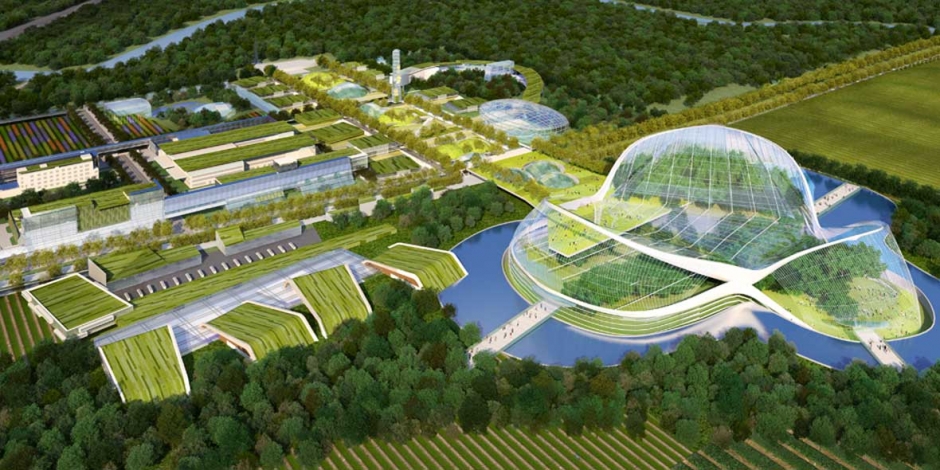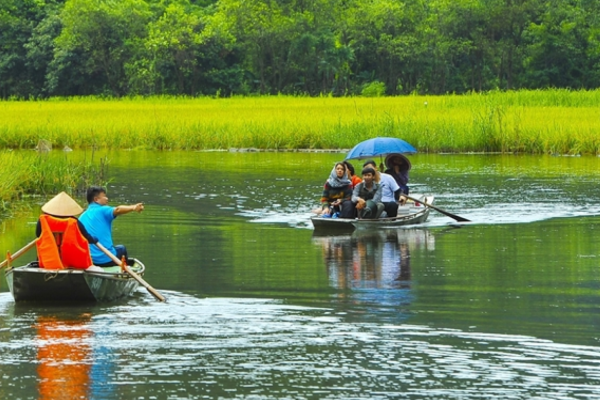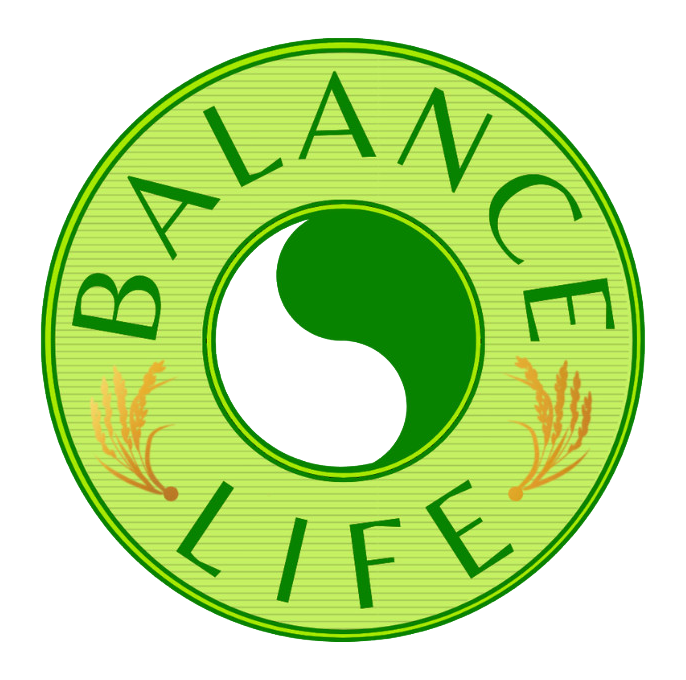- Home|
Reogranization of urban-rural space - The eco-tech village
A country's development largely depends on its people. NURTURING HUMAN RESOURCES - therefore, has always been seen as one of the breakthrough areas in economic strategies at all levels. The quality of human resources depends on two main factors: capacity and work effort.
The primary capacity of human resources comes from education and training, where the most important thing is to know what needs to be trained and how to train it. Day by day, it is increasingly realized that imparting common knowledge and information is becoming less valuable, as everyone can easily look up that information on the internet. It is also very difficult to train specific skills because the market demand is extremely diverse and constantly changing.
According to Israeli strategic experts, people in the new era only need three main universal abilities to achieve a high standard of living, meaningful life, and sustainable future.
The first ability is the ability to harmonize with nature, to create for themselves a clean and attractive ecological environment to live in as an organic part, even if the natural conditions in their living environment are unfavorable. Understanding technology in agriculture, understanding the nature of the ecosystem, and having environmental awareness are top life skills.
The second ability is to master the field of digital technology, especially programming skills and cross-space connectivity, to be able to constantly update new information, knowledge, and self-create their own digital living and working world.
The third ability is the ability to be creative, to always develop themselves, and to create new products.
Especially important is the accumulation of these three abilities, which does not happen only in a few training courses, but is a lifelong process of learning and development, heavily dependent on the living and working environment. In addition, the attractiveness of the achievements in life is an important motivation for developing human resources.
How the elderly will live, and how their journey will end when they die, has a significant impact on the labor effort throughout their lives. If the elderly do not have any good living conditions other than cold nursing homes and are treated like waste when they die, even if they have accumulated a lot of money and success throughout their lives, people will have little motivation to strive.
Organizing space is a crucial aspect that greatly influences the key stages in the formation and development of human resources of a country, a region, or a city. Space can either support or hinder the training, formation, development, and utilization of the above-mentioned core capabilities of human beings. Space also has a serious impact on the quality of life of the elderly and determines whether the image of human death and ending is beautiful or ugly, thereby affecting the development motivation of the entire society

The natural terrain characteristics of Vietnam are that 4/5 of the land is hills and mountains, which are less favorable for development, while 1/5 of the land is flat and relatively convenient. 4/5 of the population is concentrated in this 1/5 flat area. Within this 1/5 area, the majority of the population lives in an area of around 1/5 for urban construction and rural residential areas, while the rest is mainly agricultural space. In the past, this agricultural space was mainly considered as a production space, while the construction space was considered as a residential space. Clustering living spaces in a relatively narrow area can reduce infrastructure investment costs, increase interaction and social services, and at the same time allocate land for agricultural production. However, it is increasingly evident that agricultural efficiency and productivity are decreasing relatively, while urban living spaces are becoming more crowded, polluted, and facing many problems. On the other hand, agricultural areas are under pressure on productivity, leading to a trend of resource depletion, pollution, and environmental degradation on a large scale. All of these show that separating agricultural areas from residential areas and allocating a very large area solely for agriculture is becoming increasingly inefficient. In the cramped environment of urban and rural settlements, people are separated from nature, ecosystems, landscapes, feeling lonely and isolated, without social interaction even though living in crowds, and without space for creative practice. Such spaces do not support the creation of human resources with good physical and mental health, knowledge and awareness of ecosystems, community communication skills, and creative ability. Therefore, one of the breakthrough steps in planning the national rural-urban system in the next 30 years is to restructure the space, especially in the flat areas across the country, to create better living and development spaces for the majority of Vietnamese people. The basic direction for restructuring this space on a national scale is to create new, better quality living spaces for people, especially in the interface between old settlement spaces and agricultural spaces, especially in the suburban areas. These new spaces are called Eco-Tech-Villages, with 3 main characteristics as follows:
1- Eco: To create a good living environment for humans, ecological characteristics must be prioritized over agricultural production. Empty spaces, especially existing agricultural spaces, need to be restructured according to ecological principles to create a good living and sustainable agricultural production foundation. The principles of creating this ecological environment are:
- Adaptation: Minimally intervene in natural systems. Utilize the natural characteristics of each region to create a living environment and sustainable agricultural production.
- Restoration of natural systems: Especially for SOIL and WATER, to create a healthy, clean, and sustainable soil and water environment. In addition, some economically inefficient areas can be returned to nature for the restoration of biodiversity. Areas such as wetlands in deltas and coastal areas are particularly important due to their high potential for biodiversity. For areas used for agriculture, natural cultivation, circulation, ecology, and other principles should be followed to ensure that the agricultural area can also be considered somewhat of a healthy ecosystem.
2- Techno: To develop humans and society, it is necessary to rely not only on a natural foundation but also on a technological foundation. Among them, the digital infrastructure is considered a breakthrough factor and is more important than physical infrastructure. Integrating digital and physical infrastructure in smart city concepts can enhance the effectiveness of both types of infrastructure. In particular, to develop the technological factor, there must be space for experimentation, trial and error, and innovation. Technological factors need to be constantly updated rather than being completed at a specific time.
3- Village: The living and working spatial structure of people is organized as a combination of natural, ecological, technological, and living and building spaces, forming communities. Organizing space into communities is a prerequisite for creating social capabilities, social communication, and also for developing many fields of commerce, services, and innovation. However, these modern "village" structures differ significantly from traditional rural villages after the bamboo fence. The problem here is not to restore old village structures but to create new communities with some key characteristics:
-
The coexistence between the physical community and the digital community: New tech villages can be the space headquarters for large virtual communities, on a global scale, not just limited to residents living directly in one location.
-
Digital nomad village: In the digital age, residents are considered digital nomads, who can move anywhere like flocks of migratory birds within a region, a country, or globally, not heavily dependent on a specific location or a registered permanent residence. When these communities settle down, there will be developments in the latest science, technology, and trends. Therefore, "ecotech villages" are not fixed places of residence, passed down from generation to generation of a particular group of people, but rather a parking lot for constantly renewing individuals. The higher the turnover rate of users, the greater the motivation for development, updating, innovation, and space attraction value for these villages. Each space has its unique characteristics, attracting digital nomads at specific times of the year or during their life cycle, rather than being an accumulated and rigid space of a specific group of people over hundreds of years. The issue of land ownership and real estate is not as important as the usefulness and sharing of utilities for these digital nomad villages.
-
Makerhood: These villages are not primarily residential spaces like traditional neighborhoods, but are communities of living, learning, experiencing, working, and creating spaces where creative elements are the basic content of the space, not consumer elements. (Industrial living spaces are often seen as consumer spaces designed to restore and regenerate labor for workers before they go to work in factories.)
-
Transgeneration: This space needs to create a smooth transition from young to old to train young people, promote the creative process and lifelong learning, while creating activities for the elderly and utilizing the human and talent resources of the elderly group for development processes.
These "ecotech villages" need to be defined as basic urban and rural space organizations, alongside former urban areas, rural residential areas, and managed with their own regulations of construction and land law. It can be considered as a type of comprehensive infrastructure that encompasses different types of spatial organizations.
Author: Phó Đức Tùng
Related Posts

-
23-05-2023 1,366
Concentration of land - view from organic rice model in Hanoi
Kinhtedothi - In recent years, land consolidation has always been a difficult problem for localities across the country to develop large-scale commodity agricultural production areas. In Hanoi, initially appeared models with new approaches to solve this problem.

-
08-11-2022 1,744
Circular economy in agricultural production in Vietnam and proposed solutions to promote
Over the past years, Vietnam's agriculture sector has made remarkable achievements, with an average growth rate of 3% per year in the 2010-2020 period, firmly ensuring food security and export turnover of agricultural products. However, agricultural development only focuses on productivity and output, but has not paid attention to the utilization of wastes from the production process, which wastes resources and pollutes the environment.


